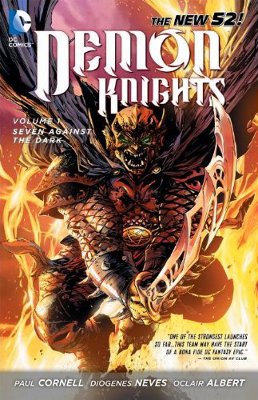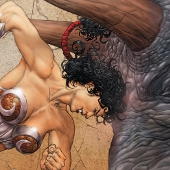Jack of All Trades – Demon Knights Vol. 1: Seven Against the Dark
 The DC relaunch set a lot of characters adrift, not just ancillary supporting characters unknown to people beyond a given title’s readership, but named characters like Wally West, former Kid Flash and longtime inheritor of the Flash mantle (prior to Barry Allen’s resurrection), and former Batgirls Stephanie Brown and Cassandra Cain. Demon Knights makes a home for DC’s more fantastical stable of Arthurian and Dark Age-inspired characters, misfits amongst the reboot’s more science fiction-oriented approach where Wonder Woman and Aquaman stand out like wizards on the bridge of the Enterprise. Nevertheless, while our titular Demon Knights can hardly be called “heroes” individually, their antics are no less superheroic than any one member of the Justice League…with a looser policy about killing, maiming, and questionable means to questionable ends.
The DC relaunch set a lot of characters adrift, not just ancillary supporting characters unknown to people beyond a given title’s readership, but named characters like Wally West, former Kid Flash and longtime inheritor of the Flash mantle (prior to Barry Allen’s resurrection), and former Batgirls Stephanie Brown and Cassandra Cain. Demon Knights makes a home for DC’s more fantastical stable of Arthurian and Dark Age-inspired characters, misfits amongst the reboot’s more science fiction-oriented approach where Wonder Woman and Aquaman stand out like wizards on the bridge of the Enterprise. Nevertheless, while our titular Demon Knights can hardly be called “heroes” individually, their antics are no less superheroic than any one member of the Justice League…with a looser policy about killing, maiming, and questionable means to questionable ends.
The Dark Ages, a period in European history following the collapse of the Roman Empire notably devoid of history, dark not so much for the grim events that filled it but more for our simple lack of knowledge as to what occurred during that time. So who’s to say a mobile empire mounted on the backs of dinosaurs didn’t rend and plunder the borderless nations of Europe aiming to conquer an ancient lost city of great and wondrous power?
 Seven Against the Dark collects the first seven issues of the series (get it? number symbolism, you’ll be getting a lot of it here) which, together, form the Demon Knights’ origin story. Seven strangers find themselves coincidentally gathered in the small village of Little Spring, an insignificant township at the foot of Alba Sarum, the aforementioned lost city. They are: Jason Blood, Merlin’s apprentice, survivor of the fall of Camelot, and host to the Demon Etrigan; Madame Xanadu, sorceress and Jason Blood’s lover; Sir Ystin the Shining Knight (Grant Morrison’s Seven Soldiers of Victory reinvention of the classic Golden Age character), a fellow survivor of Camelot born of ancient Celtic stock and the last surviving knight of King Arthur’s court; Vandal Savage, a younger, more boisterous version of the infamous DC villain; and original characters the Horsewoman, an archer never seen unmounted from her namesake horse; Al Jabr, a Middle Eastern inventor, mathematician, and expert in all things scientific (as far as the ancient world knows it); and lastly, Exoristos, a hulking warrioress from a land ancient and long forgotten even for the Dark Ages. Meanwhile, the Horde of the Questing Queen marches on Little Spring with Alba Sarum in its sights and our motley band of seven must come together to protect the tiny village from certain demise.
Seven Against the Dark collects the first seven issues of the series (get it? number symbolism, you’ll be getting a lot of it here) which, together, form the Demon Knights’ origin story. Seven strangers find themselves coincidentally gathered in the small village of Little Spring, an insignificant township at the foot of Alba Sarum, the aforementioned lost city. They are: Jason Blood, Merlin’s apprentice, survivor of the fall of Camelot, and host to the Demon Etrigan; Madame Xanadu, sorceress and Jason Blood’s lover; Sir Ystin the Shining Knight (Grant Morrison’s Seven Soldiers of Victory reinvention of the classic Golden Age character), a fellow survivor of Camelot born of ancient Celtic stock and the last surviving knight of King Arthur’s court; Vandal Savage, a younger, more boisterous version of the infamous DC villain; and original characters the Horsewoman, an archer never seen unmounted from her namesake horse; Al Jabr, a Middle Eastern inventor, mathematician, and expert in all things scientific (as far as the ancient world knows it); and lastly, Exoristos, a hulking warrioress from a land ancient and long forgotten even for the Dark Ages. Meanwhile, the Horde of the Questing Queen marches on Little Spring with Alba Sarum in its sights and our motley band of seven must come together to protect the tiny village from certain demise.
 Not unlike Frankenstein Agent of S.H.A.D.E. and Suicide Squad, Demon Knights is pure fun, especially for any fan of sword and sorcery. High adventure and thrills outweigh the cerebral but the book isn’t without substance to complement its style. While our seven protagonists are certainly heroes in our eyes with their good intentions and strong virtues (Savage and the Demon excepted), the reader will be left wondering whether their actions were ever truly heroic — several lingering images and a bit of ironic dialogue serve to punch that point home. After all, this is the Dark Ages, not the Golden Age, and a bloodless victory is more a fantasy than any dragon or fairy queen.
Not unlike Frankenstein Agent of S.H.A.D.E. and Suicide Squad, Demon Knights is pure fun, especially for any fan of sword and sorcery. High adventure and thrills outweigh the cerebral but the book isn’t without substance to complement its style. While our seven protagonists are certainly heroes in our eyes with their good intentions and strong virtues (Savage and the Demon excepted), the reader will be left wondering whether their actions were ever truly heroic — several lingering images and a bit of ironic dialogue serve to punch that point home. After all, this is the Dark Ages, not the Golden Age, and a bloodless victory is more a fantasy than any dragon or fairy queen.
Paul Cornell finds a comfortable middle ground between the often overwrought high English of certain fantasy epics and the vulgarities of modern English, giving characters diction appropriately arcane for the time without lapsing into the dissociatively elaborate. Similarly, each individual character gets enough time to form distinct personalities without any one of them dominating the book or any one of them left one dimensional and unrefined by book’s end. Nevertheless, Vandal Savage manages to steal the show on occasion with his delightful brand of barbarism as his deceptive brand of civility collides with his underlying maleficent nature. The Demon Etrigan walks away with more than his fair share of memorable moments and along with Exoristos, as the two bruisers of the group, produce the most moments of badass throughout the book.
 If forced to nitpick, the only thing I’d hold against this book is the artwork which, while enormously vibrant, colorful, and action packed, often feels claustrophobic. Think on Lord of the Rings and the fantastical visuals throughout those films, many of them will no doubt be the amazing landscape shots of New Zealand. Everything feels grand and vast whereas the scenery in Demon Knights feels tightly packed despite the lack of limitations on visuals afforded a comic book over a live action film. Even wide shots used to take in such grandiose sights as an outsized Apatosaurus with a palace straddling its back seem smaller than they ought to be because the closeness of the frame fails to adequately convey scale. While this style does succeed in making action scenes more intimate and thrilling, it fails to convey the kind of majesty you expect from a fantasy world.
If forced to nitpick, the only thing I’d hold against this book is the artwork which, while enormously vibrant, colorful, and action packed, often feels claustrophobic. Think on Lord of the Rings and the fantastical visuals throughout those films, many of them will no doubt be the amazing landscape shots of New Zealand. Everything feels grand and vast whereas the scenery in Demon Knights feels tightly packed despite the lack of limitations on visuals afforded a comic book over a live action film. Even wide shots used to take in such grandiose sights as an outsized Apatosaurus with a palace straddling its back seem smaller than they ought to be because the closeness of the frame fails to adequately convey scale. While this style does succeed in making action scenes more intimate and thrilling, it fails to convey the kind of majesty you expect from a fantasy world.
Nevertheless, the artwork excels in every other aspect and the book as a whole emerges as one of the New 52’s standout creations, vastly superior to many reboot creations for no better reason than that it actually feels like something new. I harbor no delusions about my limited readership but please, anyone who happens to read this, seek out this book. It needs all the support it can get to lead a long and prosperous run.

